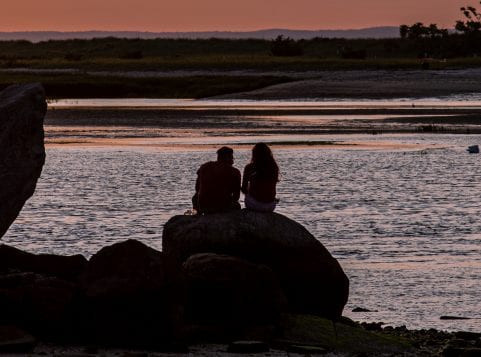The Nissequogue River State Park has become the central hub for the New York State Department of Environmental Conservation’s Division of Marine Resources headquarters.

DEC and state park officials as well as Suffolk County Executive Steve Bellone (D) gathered Oct. 7 at the state park for the ribbon cutting of a sustainability-focused facility.
Funding for the $26 million building came from New York Works, and the facility will house a U.S. Food and Drug Administration-certified shellfish microbiology laboratory. The DEC anticipates the lab will be certified by the FDA by Spring 2022.
The division currently works out of an office in East Setauket and will continue doing so while the FDA-certification process for the new Kings Park laboratory is conducted. The building also has a lobby the public can visit with a marine permit office and restrooms.
Jim Gilmore, director of the division, said the project began more than 10 years ago. He said being located in a medical park in East Setauket made them a “fish out of water” as they had 20 boats but were five miles from the shore. He said one day after a meeting in Northport he took the scenic route back and decided to stop at the park.
“I drove by here and saw the sign, and I came in and I said, ‘What a beautiful park and what a great place with the water access. Maybe we could move the marine division instead of having a leased space, actually build something here and have a cooperative thing with the parks department and run our operations more efficiently,’” he said. “So, fast forward to today, and we have this beautiful complex, this building and this property that was a terrific, cooperative effort between two agencies.”
He added that apart from the new facility making it easier to get boats in the water than the East Setauket location, it is “designed for more efficient operation of DEC marine division” and furthers its mission to understand fisheries management and manage over 30 recreational and commercial species.
“Things we used to be able to take a day for us to do we could do in a half day,” Gilmore said.
The division annually also certifies 1.2 million acres of shellfish harvest area with its FDA lab.
Basil Seggos, DEC commissioner, congratulated Gilmore on the completion of the project and said Gilmore has taken the marine division to the next level.
Seggos said for years the marine district has been under threat.
“It’s pollution,” he said. “It’s overfishing. It’s developing down on the waterfront. Now we start to look at some of these really big sort of existential problems that we have to handle — there’s multistate issues and fish migration and, of course, climate change and the warming of our waters, the acidification of our waters.”
He said battling the issues is just not a result of policies created in Albany but also the groundwork done by the division on Long Island.
“This beautiful building supports the staff that are protecting 2,700 miles of shoreline,” Seggos said, adding that it includes Long Island, the Atlantic side, all the embayments, New York City and the Hudson River.
He added that 1.2 million acres of open water is taken care of by the staff, and nearly 350,000 jobs are dependent on the work that the division does.

State Parks Commissioner Erik Kulleseid said the new DEC building and the recently opened Charles and Helen Reichert Administration Building and visitors center in the NRSP are a symbol of a relaunch of the park.
“I think this building and our building down the hill and the marina in the future are real signs that it’s time to reinvest in this park and make it into the place,” Kulleseid said, adding that the park covers 521 acres.
“It’s vitally important to aquifer recharge, all kinds of things, and in one of the most densely populated parts of the state,” he said.
Bellone said it was a joint commitment on all levels of government, including Town of Smithtown Supervisor Ed Wehrheim (R) who was unable to attend the event due to another commitment.
The county executive added that the protection of marine resources was critically important to the future of Long Island, and it was crucial to make sure those resources were sustainable.
“This is the state saying that these resources are critical and that we are committed to protecting them,” he said. “I’ve talked about this before: Water is everything here. It’s our quality of life, it’s our recreation, it’s our economy. The reason, or a large part of the reason, people live here is because of the extraordinary natural beauty, the assets, the bays, the Sound, the ocean, lakes and rivers. We have an obligation to protect it, but if we don’t we’re not going to have a prosperous future. And so this dedication of a building is a wonderful thing.”
After the press conference, New York Gov. Kathy Hochul (D) sent out a press release announcing the completion of the headquarters.
“From recreational anglers out for a day to commercial shellfish harvesters who have fished our state’s waters for generations, the health of New York’s marine ecosystem is critical to the economic health of our coastal communities,” Hochul said. “This new facility is evidence of our ongoing commitment to protecting New York’s diverse marine life while leading the way in the development of sustainable infrastructure.”
——————————————————————————————————
Facility features
• Facility is LEED silver-certified by the U.S. Green Building Council for energy efficiency construction.
• It includes water-use reduction and rainwater management features, environmentally conscious and low pollution-emitting building materials, and facilitates the production of solar-generated energy.
• Features at the new facility include:
Ground and roof-mounted solar panels equipped to generate about 100,000 kilowatt-hours of energy each year.
LED lighting, energy-efficient electrical systems, and optimized water process used to reduce consumption.
Indoor environmental air quality controls, outdoor heat-reduction materials, and reflecting paint to minimize
energy use.
Low-impact refrigerants.
Environmentally friendly, low-emitting, and recycled construction materials.
High-quality indoor daylight and views of natural outdoor spaces to reduce the use of electrical lighting.
Green and electric vehicle parking and charging stations for visitors and staff.
Bike rack and a connection to a nature trail.
Rainwater bioretention and rain gardens to help reduce stormwater runoff.
Native and adaptive plants and trees to promote the health of the local ecosystem.













































